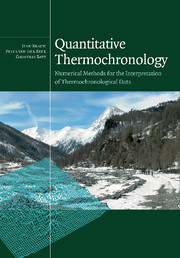Book contents
- Frontmatter
- Contents
- Preface
- 1 Introduction
- 2 Basics of thermochronology: from t–T paths to ages
- 3 Thermochronological systems
- 4 The general heat-transport equation
- 5 Thermal effects of exhumation
- 6 Steady-state two-dimensional heat transport
- 7 General transient solution – the three-dimensional problem
- 8 Inverse methods
- 9 Detrital thermochronology
- 10 Lateral advection of material
- 11 Isostatic response to denudation
- 12 The evolution of passive-margin escarpments
- 13 Thermochronology in active tectonic settings
- Appendix 1 Forward models of fission-track annealing
- Appendix 2 Fortran routines provided with this textbook
- Appendix 3 One-dimensional conductive equilibrium with heat production
- Appendix 4 One-dimensional conductive equilibrium with anomalous conductivity
- Appendix 5 One-dimensional transient conductive heat transport
- Appendix 6 Volume integrals in spherical coordinates
- Appendix 7 The complementary error function
- Appendix 8 Pecube user guide
- Appendix 9 Tutorial solutions
- References
- Index
8 - Inverse methods
Published online by Cambridge University Press: 15 December 2009
- Frontmatter
- Contents
- Preface
- 1 Introduction
- 2 Basics of thermochronology: from t–T paths to ages
- 3 Thermochronological systems
- 4 The general heat-transport equation
- 5 Thermal effects of exhumation
- 6 Steady-state two-dimensional heat transport
- 7 General transient solution – the three-dimensional problem
- 8 Inverse methods
- 9 Detrital thermochronology
- 10 Lateral advection of material
- 11 Isostatic response to denudation
- 12 The evolution of passive-margin escarpments
- 13 Thermochronology in active tectonic settings
- Appendix 1 Forward models of fission-track annealing
- Appendix 2 Fortran routines provided with this textbook
- Appendix 3 One-dimensional conductive equilibrium with heat production
- Appendix 4 One-dimensional conductive equilibrium with anomalous conductivity
- Appendix 5 One-dimensional transient conductive heat transport
- Appendix 6 Volume integrals in spherical coordinates
- Appendix 7 The complementary error function
- Appendix 8 Pecube user guide
- Appendix 9 Tutorial solutions
- References
- Index
Summary
So far, we have provided the reader with a variety of mathematical methods, including analytical, semi-analytical and numerical ones, with which to solve the heat-transport equation in a wide range of situations. The purpose of these calculations has been to produce thermal histories that are then used to predict thermochronological ages of a form that allows their comparison with real data that a geoscientist might be able to acquire. Through this comparison, we hope to provide constraints on tectonic or geomorphic processes.
In this chapter, we propose a different approach in which the thermochronological data are directly ‘inverted’ to provide quantitative estimates of parameters that are direct measures of a tectonic or geomorphic process, such as the mean rate of rock exhumation (which is related to tectonic uplift) and the rate of change of surface relief. As we will show in later chapters, these ‘inverse’ methods can also be used to provide direct constraints on a wide range of parameters characterising tectonic events, such as the geometry of active faults, the thermal properties of the crust and the evolution of surface relief through time.
Spectral analysis
In Section 6.1, we showed how the thermal perturbation caused by finite-amplitude surface topography decreases exponentially with depth at a rate that is proportional to the wavelength of the topography (Turcotte and Schubert, 1982; Stüwe et al., 1994; Mancktelow and Grasemann, 1997).
- Type
- Chapter
- Information
- Quantitative ThermochronologyNumerical Methods for the Interpretation of Thermochronological Data, pp. 122 - 130Publisher: Cambridge University PressPrint publication year: 2006



